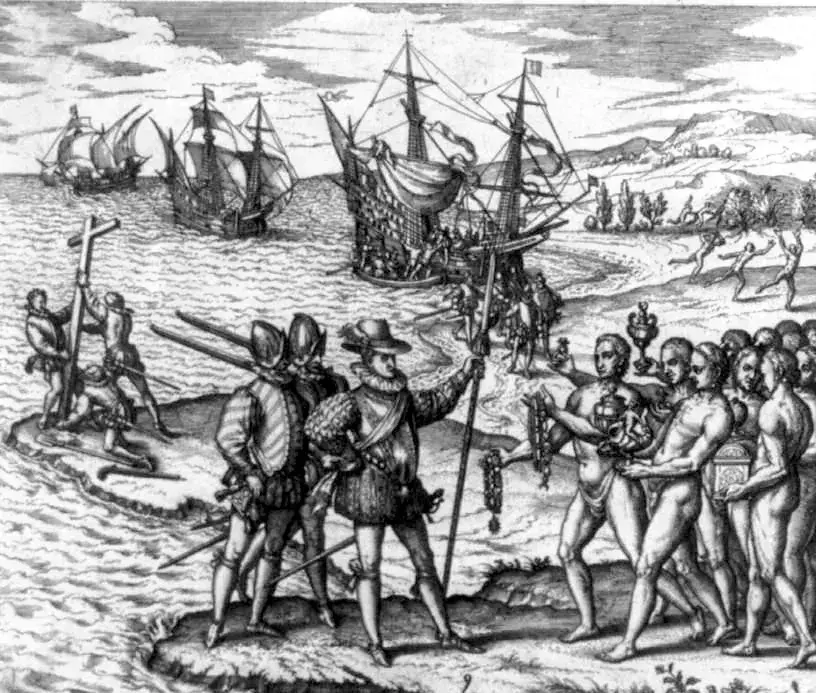
Migration politics reignite fears and animosity 200 years in the making.
SANTO DOMINGO, Dominican Republic — In a video that went viral last October, a Dominican police officer stands holding a Haitian flag before a group of Haitian men, one of whom clasps the other side of the emblem. Then, with swift movements, the officer brandishes a butcher knife, shreds the flag and stomps on the Haitian symbol.
All the while, the officer curses Haiti, saying the flag doesn’t belong in the Dominican Republic. The 13 Haitians in the frame stand watch – looking with varying reactions – amusement, incredulity, resignation.
Reactions to the video – both condemning and defending the soldier’s actions – were swift. And expected.

As a nonprofit journalism organization, we depend on your support to fund more than 170 reporting projects every year on critical global and local issues. Donate any amount today to become a Pulitzer Center Champion and receive exclusive benefits!


The video, undated and unverified, appeared in the middle of two significant series of events. The first one: A series of heinous, unrelated crimes in various towns that occurred weeks prior for which Haitians were blamed. According to local media in the DR: three Dominicans were found with their throats slit, a 33-year-old Dominican was bludgeoned with a machete, another Dominican was hacked to death, and a 12-year-old girl was sexually assaulted. The second: Days after the video posting, Dominican immigration authorities repatriated nearly 140,000 Haitians en masse, expelling about 700 people daily.
When the United Nations High Commissioner for Human Rights demanded a halt to the deportations, Dominican President Luis Abinader pushed back, calling the U.N. statements “unacceptable and irresponsible.”
Abinader added, “The Dominican Republic has carried the most, has been economically affected the most, and has shown more solidarity [with Haiti] than any other country in the world.”
The 40-second video, the media reports pointing the finger at Haitians as perpetrators, the mass expulsions, and the accompanying rhetoric, combined and all taking place relatively quickly, highlight an animosity that runs deep between the two nations. It’s a loathing that has become too common of an occurrence online whenever news breaks about Haitians and Dominicans. The enmity finds ways to make itself known offline as well, from everyday interactions, to diplomatic meetings, to governmental policy.
By and large, most Haitians and Dominicans get along just fine on either side of the border – at work, in social settings and the like. However, the virulence of patriotism on both sides is symptomatic of the animosity that has hovered over Hispaniola, the island the two countries share, for centuries.
Some historians and advocates for better Dominican Republic-Haiti relations say the enmity stems from a deep-seated fear among Dominican leaders that Haitians want to rule the whole island. Bloodshed both fueled the initial resentment early in the 19th century and re-ignited hostility in the 20th according to scholars who have studied both nations.
Fear of an invasion. That’s what it all comes down to, said Jesùs Ruiz, a historian of Latin America and the Caribbean, the Atlantic World, and Haiti.
“Fear is also at the core of the way the Dominican state is engaging in these terrible repatriation laws,” said Ruiz, who is working on a book called “The Black Royalists: Haiti and A Politics of Freedom in the Atlantic World” at Vanderbilt University.
The Dominican Republic has a population of 11.3 million. According to the United Nations Department of Economics and Social Affairs (UNDESA), about 5% of residents are Haitian, making the nationality the largest immigrant group in the Dominican Republic. In 2017, the 330,000 Haitians in the Dominican Republic made up 4% of the population, according to a report by the Organization for Economic Cooperation and Development (OECD) citing UNDESA figures. In 2022, after an array of political, social and economic crises pushed thousands to leave Haiti in search of safety and opportunity, the numbers grew to about 496,000, according to UNDESA.
A growth of 1% over five years.
The half-million Haitians living in the Dominican Republic – called an “invasion” by critics – make up the second-largest Haitian Diaspora group, coming in only after Haitians in the United States. In contrast, according to OECD Development Center researchers, the Haitian labor force has been a boon for the Dominican economy, particularly in agriculture and construction. Nowadays, many of the recent Haitian settlers are those with some means, formal education and ties to family and friends in America.
So where does the idea that Haitians want to, can and will invade the Dominican Republic? Why are Dominicans intent on stirring up what one scholar calls “a selective nationalistic fragility?”
The answer, at least parts of it, lies in the shared history, in tales older than both nations and influenced by much larger global powers.
Fractured from the start
Hispaniola, the second-largest island after Cuba in the Caribbean, spans 29,418 square miles. Haiti sits on one-third of it, 10,714 square miles on the western side. The Dominican Republic has the other two-thirds, which amounts to 18,704 square miles.
Before both nations existed and before the Europeans arrived, the Taíno and Arawak indigenous peoples inhabited the entire island, ruling it as five kingdoms called caciques, each with its own ruler. Researchers have said the estimated population ranged from several hundred thousands to over 1 million.
In 1492, the Spaniards landed on Ayiti Kiskeya Boyo. The colonizers promptly changed the island’s name to La Española, which eventually evolved into Hispaniola. The Spaniards forced the indigenous Arawaks who lived there into harsh labor to mine gold on the island, produce sugar – annihilating them within about a decade. The Spaniards then brought 4,000 kidnapped Africans into Hispaniola, the first to arrive in the Western Hemisphere, to force into slave labor. Over the subsequent decades, thousands more Africans were brought to the island, at modern-day Santo Domingo specifically.
Meanwhile, the French slowly invaded the western part of the island, causing conflicts between France and Spain. In 1697, Spain ceded the western part of Hispaniola to France through the Treaty of Ryswick, with the European powers agreeing to stay on their side – calling that third of the island Saint-Domingue in French and the rest Santo Domingo in Spanish.
At that point, the island’s inhabitants were still interconnected, despite being under two different colonial powers and systems.
“In some ways, it’s the root, but that [conflict] begins to come later after independence,” Ruiz said. “There’s always going to be the differentiation between French culture and Spanish culture from the early moments, but those communities were connected.”
Bloody rebellions, battles and massacres
On the Saint-Domingue side, the enslaved Africans’ rebellions took hold from 1791 on, growing into the Haitian Revolution that successfully defeated the French in 1803 to form the First Black Republic. Haiti became officially an independent nation on January 1, 1804.
About a year later, France tried to retake its former colony by sneaking soldiers in from the Santo Domingo side. Haiti’s newly-minted emperor, Jean-Jacques Dessalines, ordered Haitian soldiers to go fight the French colonizers on the Santo Domingo side.
About 500 residents on the Spanish side were brutally killed in that military action in 1805 known as “El Deguello de Moca,” Spanish for The Beheadings of Moca.
Historian Lissette Acosta Corniel is a Dominican-American assistant professor of Latin American Studies at the Borough of Manhattan Community College. She says many Dominicans view the beheadings as the Haitians’ attempt to take over the whole island.
“What [Dessalines] wanted was to defeat the French,” Acosta said. “It wasn’t a battle between Haitians and Dominicans. It was newly free enslaved people trying to get rid of the colonizers.”
Ruiz also refutes the long-held belief that Haitians tried to invade the eastern side of the island.
“You [Dominicans] claim that this nation has occupied you, has invaded you, but you’re not a nation yet,” Ruiz said. “How can a nation invade and occupy a nation that doesn’t even exist?”
Ruiz is referring to the Spanish-speaking side still being under colonial rule at the time. Haiti was under President Jean-Pierre Boyer, who tried to implement agricultural reforms and other tactics across the whole island.
Dominican elites, scared that Haitians would try to occupy them, formed a secret patriotic society to fight against Haitians in 1838. La Trinitaria wanted Dominicans to differentiate themselves from Haitians and create their own identity. That effort led eventually to defeating the Haitian army on February 27, 1844.
Movement across border as a political tool
Through the early 1900s, political turmoil and infighting among rulers of both new nations struck on both sides. Haiti saw numerous presidential assassinations that prompted the U.S. to occupy it from 1914 to 1934. The Dominican Republic.
In the early 1900s, scores of Haitians lived along its border in Dajabon and were in harmony with the Dominicans. However, Dominican President Rafael Trujillo claimed that Dominicans were complaining about Haitians stealing their goods. Trujillo said he would “fix this” in a speech.
Trujillo ordered the killing of people of Haitian origin in Dajabon. Dominican soldiers deemed people to be Haitian if they mispronounced the word perejil, parsley in English. As many as 20,000 people were killed in the massacre in 1937, according to Latin American Studies.
“The Parsley Massacre crystalizes a lot of those anti-Haitian Dominican nationalist discourses in the most horrific way,” Ruiz said. “[It] is a reaction to the resistance of African descendant Dominicans at the border who were continuing their connection to Haitians.”
After the Parsley Massacre, Haitians resumed going to the Dominican Republic for work and business and many Dominians traveled to Haiti also for business and leisure, all the way into the 1990s. On June 13, 1991, then-President Joaquín Balaguer ordered the repatriation of foreigners working in sugarcane plantations. About 6,000 Haitians and Dominicans of Haitian origin were deported and tens of thousands of others left on their own.
In 1993, yet another influx of Haitians moved to the Dominican Republic. This time, they moved there to work in sugar plantations, or “bateyes.” Over time, they settled on or near the plantations, forming generations of Haitian-Dominican families.
The next major inflow of Haitians in the Dominican Republic happened in 2010 after a 7.0 magnitude earthquake in Haiti. An estimated 200,000 Haitians moved to their neighbors’ land, according to the International Organization for Migration. Gang violence, hunger crisis and political instability in Haiti later spurred more Haitians to cross the border, prompting Dominican officials to plan mass repatriations.
Researchers: Invasion narrative manufactured
For Haitians in recent years, the Dominican Republic is a natural escape route when conditions in Haiti get tough for many reasons.
For one, it’s relatively cheap to reach. These days, the trip by bus costs 5,000 pesos, or about $90 USD. For another, global changes underway, including digital technology and other innovations that make it possible to work in an array of fields, is drawing not only manual laborers, but people with formal education who are able to fill white-collar roles. And as the Dominican Republic has become “one of the fastest growing economies in Latin America and the Caribbean in the last decade,” according to the World Bank, there is opportunity across the board for Haitians to build decent lives – if they have legal status.
The OECD, in a 2017 report about how policies affect migration, said the Dominican Republic would benefit from immigration rules that recognize the potential of its immigrant workforce.
“The current development agenda is placing emphasis on the challenges rather than the potentials of migration,” the report’s authors said. “Migration can benefit economic and social development in the Dominican Republic, but its potential is not yet fully realised [sic]. Many sectoral policy makers do not yet sufficiently take migration into account in their areas of influence.”
Instead, Haitian migration has prompted some people, many of them prominent politicians like former presidential candidate Soraya Aquino, to call the influx an invasion. Opponents of Haitian migration Haitians take up physical space and put a strain on resources such as healthcare and schooling. They point out statistics such as Haitians making up 30.9% of all people who gave birth in a public hospital, or 16,459, between January 2022 to June 2022.
These developments certainly influence public reaction to incidents such as the flag shredding going viral. They also cause more serious consequences for families, including some who were the 140,000 Haitians that the Support Group for Returnees and Refugees (GARR) removed from the Dominican Republic in 2022.
To help prevent illegal migration, Dominican President Luis Abinader began building a wall between the two countries in 2022. The wall is set to be 244 miles long, which is half the length of the border.
For many scholars, political observers and ordinary citizens alike, the tension-fueling rhetoric around Haitians living and working in the Dominican Republic is fearmongering to fit certain agendas.
“There has been scaffolding of events in the Dominican narrative that unfortunately markets only the negative parts,” Acosta said, referring to the ways colonial history is taught in the Dominican Republic.
As for current-day relations, she said, “The positive of both the undocumented immigration and the documented is not highlighted on the Dominican side because those who are fed the negative narratives only want to focus on what they see.
“They see a lot of Black people. But they don’t see the positive economic relationship that has been built in the Dominican Republic,” Acosta added. “No one is talking about that because it’s not convenient.”
Moving toward those positive perceptions are people like Paraison, whose Zile Foundation aims to create friendship connections between Dominicans and Haitians that go beyond the viral-inducing rhetoric.
“When talking about a solution, the first thing we need is dialogue,” Paraison said. “The second thing is being aware of what’s called interdependence. We’re two countries interdependent. We need to open more windows of cooperation.”







